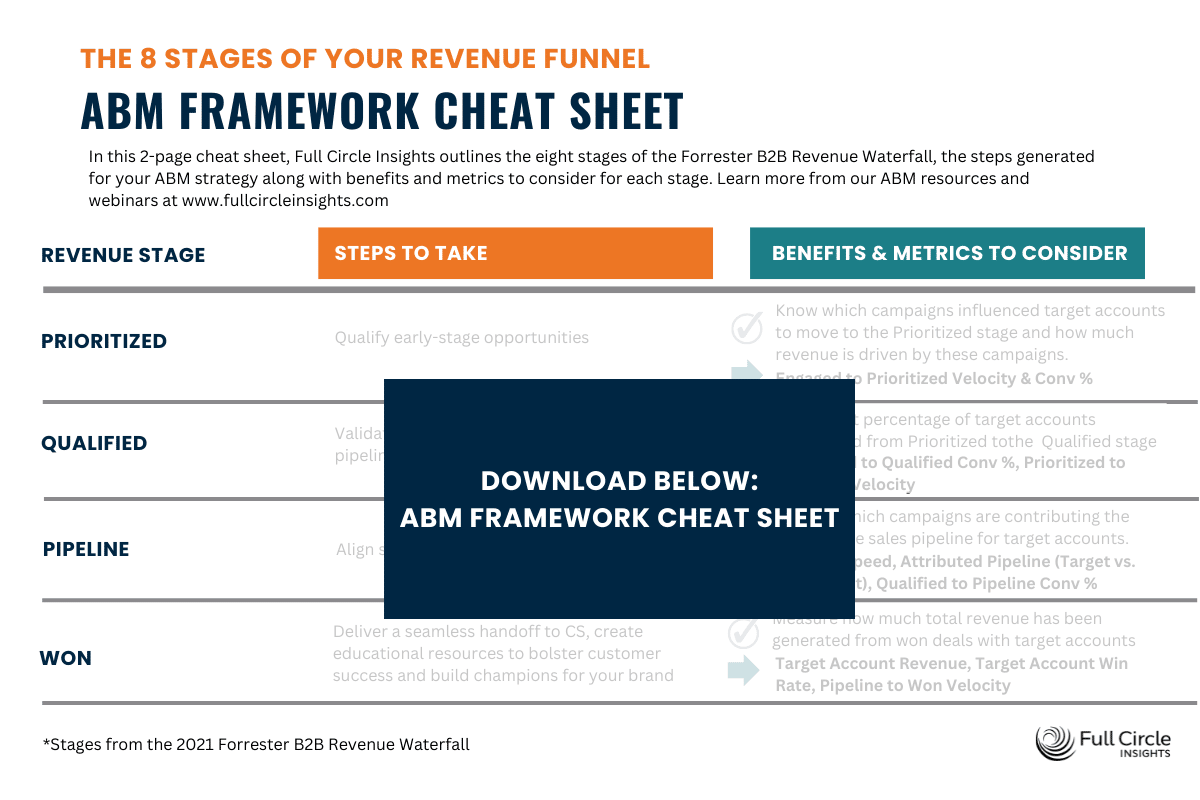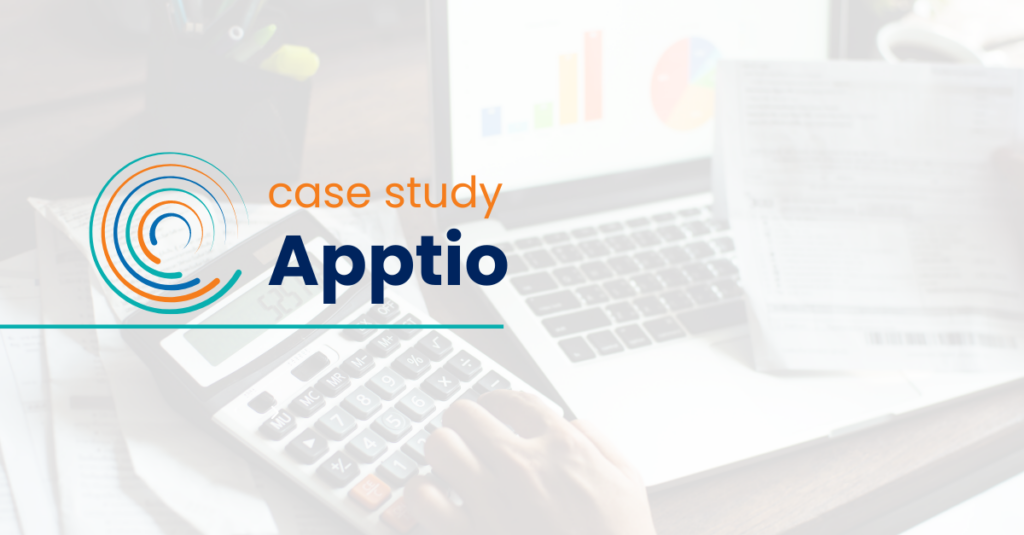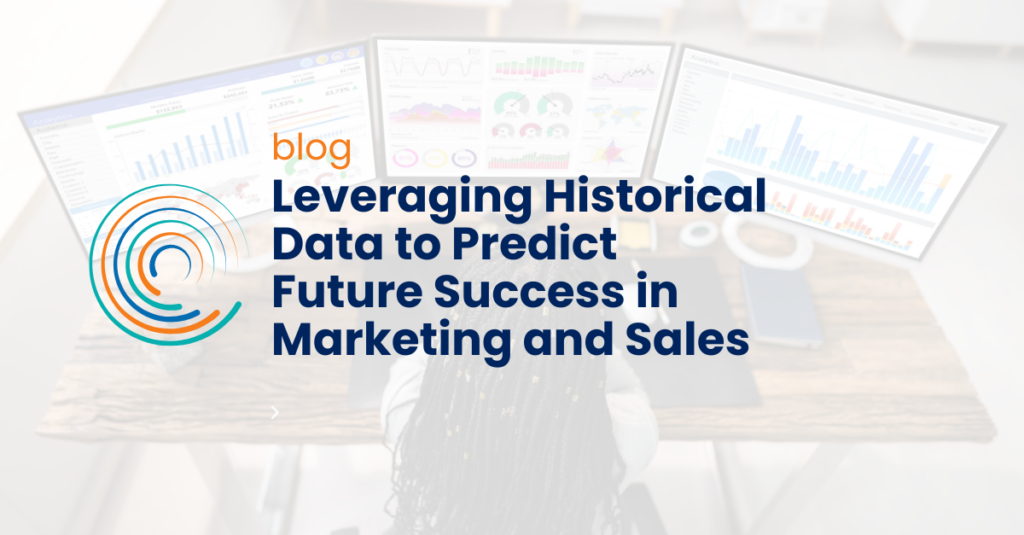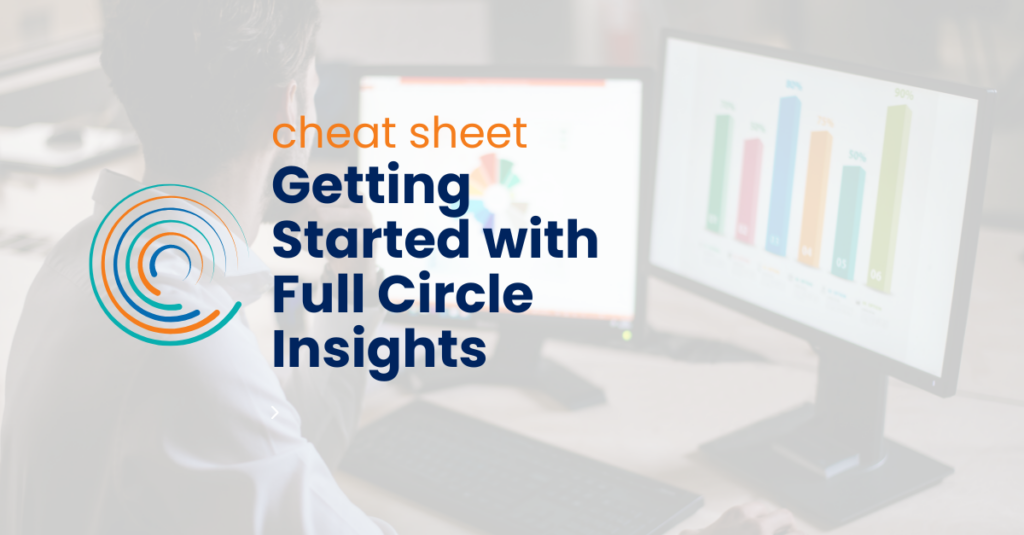The Forrester B2B Revenue Waterfall is a popular framework for B2B marketers who are using an account-based marketing (ABM) strategy. It works well because it fully describes revenue opportunities — breaking them down into acquisition, retention, upsell, and cross-sell categories — and because it defines eight revenue stages that accurately reflect the ABM experience.
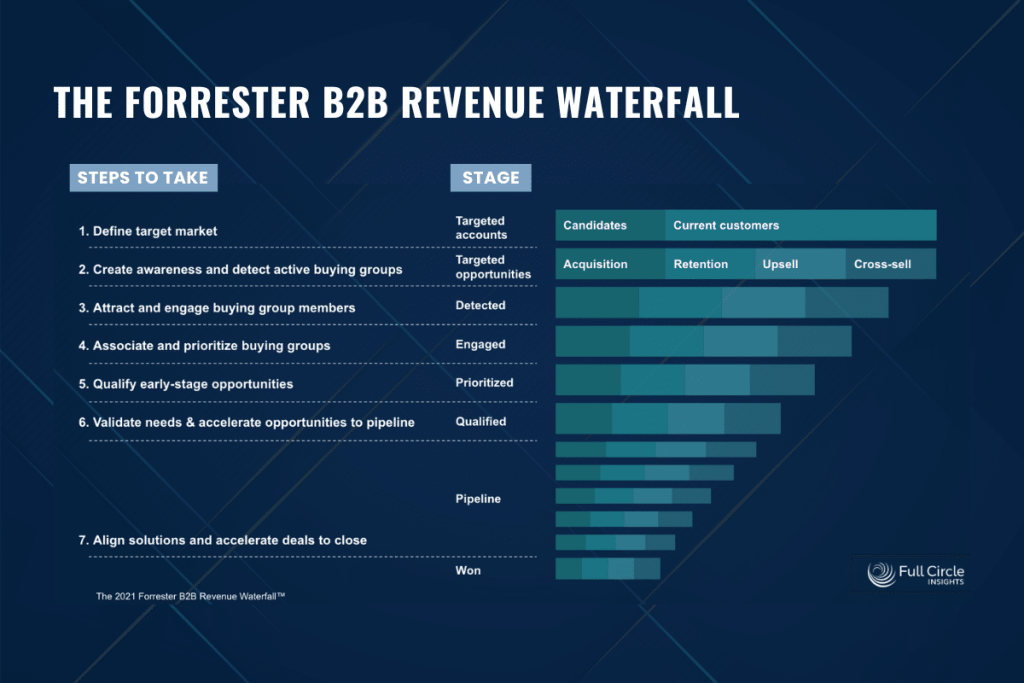
Have you ever wondered what steps you should take at each revenue stage, what results to expect, and which Full Circle ABM metrics can be most helpful at each juncture? We’ve created an ABM Framework Cheat Sheet that can help.
Here’s a look at how Full Circle ABM metrics can guide you to marketing success with accounts-focused campaigns. You can download the ABM Framework PDF here to guide you as we walk through each of the revenue stages below.
- Targeted accounts: In this stage, marketing and sales work together to define the Ideal Customer Profile (ICP) and identify targeted accounts, marking them in the CRM to track them through the waterfall. Marketing and sales use the CRM as the single source of truth for metrics, which aligns the two teams, a key benefit of an ABM approach. Recommended metrics for this stage are Targeted Account Volume and Total Target Accounts, which are important to initially make note of and then expand as appropriate (on a quarterly basis, for example) throughout the year.
- Targeted opportunities: Stage 2 is where the marketing team creates brand awareness and identifies buying groups. Full Circle ABM lets marketers measure buying group members to ensure they know how many contacts for each account have been identified. Key metrics at this stage are Account Volume Trends, which uniquely leverages historical data inside the CRM to provide insight on account volume over time, and Accounts with Buying Group Members, which makes it possible to track activities across both account-based and person-based funnels.
- Detected: At this stage, marketing uses intent data to identify target accounts that are showing interest by researching topics related to the company’s products or services. Recommended metrics here are Detected to Engaged %, which tells marketers how well they’re doing converting accounts from stage 3 to stage 4, and the Detected to Won %, which is the conversion rate from stage 3 to stage 8. These metrics are useful for creating a baseline for ABM programs so you can project what percentage of targeted accounts will convert to won business and look at ways to increase the win rate. You can also do a reverse waterfall using these metrics to determine if you have a sufficient number of targeted accounts to hit revenue goals.
- Engaged: In stage 4, marketers associate and prioritize the buying groups, monitoring campaign performance and tying campaigns to results on the sales side. This provides an opportunity to optimize campaigns to increase the number of engaged accounts. Recommended metrics for this stage are the Engaged Account Conversion % and Engaged to Won %, which allow marketers to make more efficient campaign investment decisions. For example, based on performance, marketing might decide to redirect campaign dollars from an underperforming campaign to one that is more effectively driving conversions or won business.
- Prioritized: In this stage, marketers qualify early-stage opportunities, identifying which campaigns influenced target accounts to move to stage 5. This is a pivotal stage in the framework because you can flag accounts that are responsive for further attention from sales. Stage 5 is also where you can attribute revenue to campaigns. Recommended metrics are Engaged to Prioritized Velocity and Conversion %, which provide insight on the speed at which campaigns are moving accounts from stage 4 to stage 5 and conversion success.
- Qualified: In stage 6, marketers validate the needs and accelerate opportunities to the pipeline, monitoring campaign performance as the sales team follows up on accounts that were marked as priorities in stage 5. In an ABM strategy, marketing and sales collaborate more closely, so after the handoff, marketing continues to assist and track progress. Recommended metrics are Prioritized to Qualified Conversion % and Prioritized to Qualified Velocity, which tell you what percentage of accounts are converting and how quickly they are moving between stages 5 and 6.
- Pipeline: At this stage, the team aligns solutions with accounts and accelerates deals toward won business. For marketers, it’s critical to identify the campaigns contributing the most to the sales pipeline and campaigns that increases deal velocity and shortens sales cycle. Three key metrics can help here — Pipeline Speed, Attributed Pipeline (Target vs. Non Target), and Qualified to Pipeline Conversion %. Pipeline Speed is important because the faster accounts move, the more sales can be generated. Attributed Pipeline is a key metric because it tells you whether your ABM approach is working, i.e., are targeted accounts responding vs. non targeted accounts. The Qualified to Pipeline Conversion % lets you know how effectively you’re moving accounts from stage 6 to stage 7.
- Won: The final stage is when the marketing and sales teams seamlessly hand off won accounts to the customer success team. Marketing’s role at this stage is to continue to provide educational resources to ensure customer success and create brand champions. Key metrics include Target Account Revenue, Target Account Win Rate and Pipeline to Won Velocity, which allow you to measure the total revenue your ABM campaigns generated, the speed campaigns moved from stage 7 to 8 (a key performance indicator for process efficiency) and gain insights needed for campaign optimization so you can improve performance going forward.
Keep in mind the Full Circle ABM metrics highlighted in the ABM Framework Cheat Sheet aren’t the only metrics available from Full Circle ABM. The performance measurements recommended for your consideration can help you gain insights at specific revenue stages as explained above, but there are many more metrics available that can be helpful in a wide variety of ABM scenarios.
The Forrester B2B Revenue Waterfall provides important context for marketers who are using an ABM strategy. You can use the ABM Framework Cheat Sheet as a companion guide that can help you plan, execute and measure your ABM campaigns. By more closely aligning with your colleagues in sales and measuring performance at each stage, you’ll have everything you need to drive marketing success.
Save this eBook for later.
Learn how to measure and engage key accounts, and identify top intent providers to enhance your ABM strategy.
